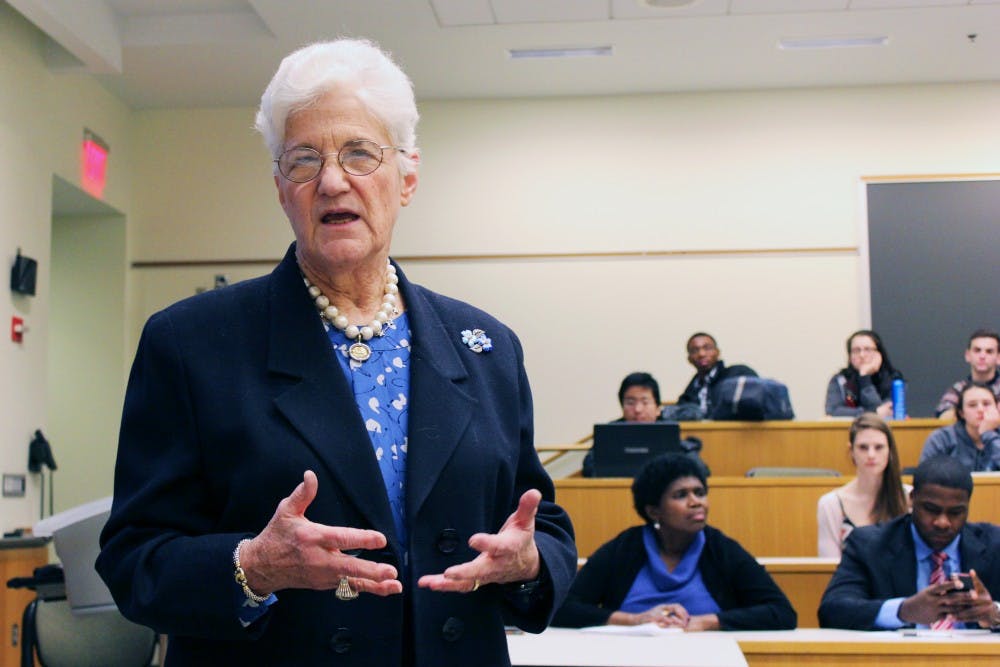With little more than a month until the May 19 election for Philadelphia’s mayor, the advertising wars have begun.
After 74-year-old candidate Lynne Abraham collapsed at Tuesday's televised debate, the former District Attorney might be in need of an image revamp.
Her fainting spell robbed the candidate of an important opportunity to challenge the front-runners, former City Councilman Jim Kenney and State Sen. Anthony H. Williams. Now, Abraham has to fend off criticism that she is unfit to maintain the vigorous office of mayor.
With no advertising campaign yet, Abraham will need to generate a more prominent message.
“Abraham especially needs something coming out after last night to counter the image of whether she’s really up to [being mayor] at 74 years old,” St. Joseph’s University Professor Randall Miller said.
However, Abraham lacks the funding sources of well-supported candidates like Kenney and Williams. She also failed to receive key endorsements from the National Organization of Women and the Fraternal Order of Police, who both endorsed Kenney.
This lack of generalized support puts her at odds with Kenney, against whom Abraham will compete for white votes. Without key endorsements or a serious funding base, Abraham will continue to struggle for donor support.
“The fact that she’s not on the air yet is a serious problem. It’s a problem for her because it suggests a weakness rather than a strength, so it discourages people to give her money,” Miller said.
Abraham’s campaign released an internal poll in late March that put her in the lead among all Democratic candidates with 30 percent of the vote. The poll provoked some doubt from pundits for its counterintuitive results. For instance, Abraham drew 24 percent of black voters compared to only 22 percent for Williams in a city that generally votes along racial lines.
“It’s not clear that she is the front-runner. It’s an internal poll and internal polls by other candidates say otherwise,” Miller said.
An early April poll from Kenney supporters put him in the lead at 26 percent of votes, with Williams and Abraham trailing closely behind.
In terms of sheer financial support, Williams’ campaign is far and away the leader.
The American Cities super PAC, formed by three wealthy suburban proponents of school choice, has already spent $1 million for ads supporting Williams.
Since the 2010 Supreme Court decision in Citizens United v. FEC, special interests have flooded the airways with issue-oriented ads. These ads, which do not endorse a specific candidate, are not subject to traditional campaign finance regulations.
Other independent groups have popped up to support Kenney, including Forward Philadelphia and Building a Better PA. These education, LGBT and labor-focused groups reflect Kenney’s recent endorsements by the teachers’ union, LGBT activists and AFL-CIO labor union in Philadelphia. These groups have totaled at least $490,000 in advertising for Kenney.
Uncertainty about the identities of the financial backers of these independent groups has prompted criticism of “dark money” entering the race.
In Tuesday’s debate, moderator Jim Rosenfield asked Williams about the presence of dark money in his ads. On Wednesday, Williams was found to have committed campaign finance violations and must pay fines to the city.
“I’m the only person on this stage that pays for my own ads. There’s another candidate, Jim Kenney, who uses dark money for his ads,” Williams said. In addition to super PAC-funded ads, Williams’ campaign committee contributed $200,000 toward officially sponsored advertisements.
“I don’t know who is funding my commercials,” Kenney said in response to Williams’ accusation.
Professor Miller called “balderdash” on Kenney’s statement.
“He may not know all the players but he knows where the money is coming from,” Miller said.
Regardless of debates over funding, all signs point to more advertising in the run up to the May 19 primary election. Some of those ads, which benefit from being funded through outside sources, may take a more contentious tone.
“What we haven’t seen is negative advertising yet. They’re going to come as well,” Miller said.
If the tenor of previous debates and forums is any hint, negative ads will be a certainty.



